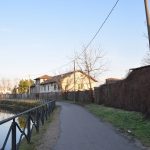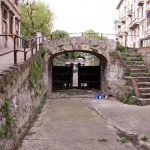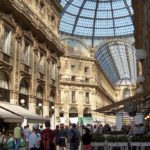Walking to Gorgonzola, all along the Naviglio Martesana
Milan: The Naviglio Grande
Experience the thrill of sailing in Milan
This is the Naviglio Grande that connects the Ticino river to Milan, and as a result, even Lake Maggiore. There are barges here, just like in Holland, and small bars and cafés in the corners. The tram runs past here, and it looks like a northern city!
Leonardo da Vinci reorganised the Naviglio system in the 16th century, which meant there was a waterway that would carry the traffic, that nowadays, of course, all goes by road. The Naviglio was made for sailing on, and tourists here have the opportunity to experience the thrill of sailing in Milan!
⇒ Watch the full web serie Milan & Leonardo da Vinci
Visit Turismo Milano official website
Cover pic courtesy of Flickr User Ste @stepk
Video full text: The Naviglio Grande
This is the dock, it’s only just recently been sorted out.
There are barges here, just like in Holland, and small bars and cafés in the corners.
The tram runs past here, and it looks like a northern city.
The use of the rivers is something that is ancient and yet modern.
Perhaps this is the future!
Reactivating the Naviglio and the dock means reviving one of Milan’s key features.
This is the Naviglio Grande that connects the Ticino river to Milan,
and as a result, even Lake Maggiore.
It was dug by the Cistercian monks in the 13th century.
The barges would arrive here from Lake Maggiore carrying marble.
They bore letters A.U.F., which stood for Ad usum fabricae, i.e. for the Factory of the Duomo.
Because they were exempt of duty, nothing had to be paid!
And that’s also why people say to eat “ad AUF” (Milanese for ‘to eat for nothing’), right?
And all these flowers? Really lovely!
This is my workshop and I keep it hidden away,
so that people think I sell flowers, whereas I actually make bags.
An artisan bag maker, I’m going to have a look!
This is a wonderful corner, a special place on the Naviglio,
it’s the towpath’s narrowest point and only I can see it!
Davide Gatto is a resourceful young artisan
who spent many years abroad, gaining an understanding of how fashion changes
and how customers change the manner in which they shop.
The beautiful customers like to go hunting,
just like when you don’t want to go and dine in restaurants that everybody else eats in,
but you want to look for just that perfect small place to dine.
I’ve decided to create something that is a little old school, a home-workshop.
I live here, next door, and so I’ve opened a small studio here.
I make ten bags a month, that’s around 120 in a year.
They’re rare and very beautiful!
All I wanted to do was to exhibit a truly Italian-made product, above all during Expo.
These are my own peculiarly unique models, and I also customise other, already made bags, to order.
It’s the sort of service that no longer exists in the centre of Milan,
so it felt right to set up shop against the backdrop of the Naviglio.
I didn’t want an aseptic place in which to just display only the bags,
so I mixed the bags with what for me is the Naviglio.
Milan is always a part of Italy, it has its toes dipped in the Mediterranean,
and its head a bit further north, where the air is that of Central Europe,
even if there is more of an Italian liveliness.
This space endeavours, through my aesthetic taste, to tell my vision of the city.
I mix the old with the new, with the know-how of Italian tradition.
Precisely what I was looking for.
I found it naturally by chance, but the place was just right.
Real tourists have to be able to get lost!
In the end fashion looks more to the street,
it’s not down to me to decide that this year pink is in and that everyone will go with pink.
There is no longer a trend, and the word itself is now almost a rude word in the world of fashion.
Naturally everything is vintage,
with old tables and old iron benches.
This is the restoration of something that was once beautiful and can be again.
Further along the Naviglio we find a small detour in the canal,
where, until the 1950s, the laundry workers came to wash clothes.
Entering the Vicolo dei Lavandai (the alleyway of the laundry workers) it’s as though we’ve travelled back to the 19th century.
Up until the 19th century these service were provided by men who formed part of a confraternity.
It was an organisation. The items to be washed would arrive here and everything was organised in relation to the canal that brought the water.
This is the area of the courtyards, where the countryside once was.
The area around the Naviglio was a hive of activity.
Leonardo da Vinci reorganised the Naviglio system in the 16th century.
which meant there was a waterway that would carry the traffic,
that nowadays, of course, all goes by road.
Wouldn’t it be good if the Navigli were to be revived, but then again, all the waterways in general.
All of Europe used to use the waterways to get around,
and all cities were built using this logic.
Cities didn’t have rivers, they had canals.
The Naviglio was made for sailing on. Do you?
We operate a tourist service, with a trip that lasts 50 minutes.
We offer tourists the opportunity to experience the thrill of sailing in Milan!
Please!
Come aboard.
The Naviglio measures 49.9 km in total, that’s virtually 50 km.
We sail six kilometres, three on the outward leg and three on the return.
If we carried straight on up the canal, we’d reach the power station in Turbigo.
The aim is always that of reaching Lake Maggiore via the Ticino.
Everything used to use the canals, there were no trucks and freight arrived here by water.
The barges used the currents for propulsion.
It may not seem like it, but we have a current of 7 to 8 kilometres per hour here.
And at certain times it’s even faster.
To come back upstream required the use of horses to pull the barges.
There were times during the day when it was possible to travel upstream and others when it was possible to travel downstream.
Every so many kilometres there were staging posts where the horses were changed.
The tired horses were replaced with fresh ones, a bit like a stagecoach would do.
Do you think that this is what brought Milan its wealth?
That’s what history tells us! I wasn’t around then because it was the 13th century.
We’re now travelling against the current.
The Naviglio Grande comes into Milan, whilst the Naviglio Pavese leaves it.
If anyone outside of Milan wants to know which Naviglio they are looking at, all they need to do is keep an eye on the current.
This is the church of Santa Maria delle Grazie al Naviglio,
We continue sailing against the current
and come across some single-storey residences along the side of the canal, just as they were in bygone times.
That was the house of the poet, Alda Merini.
There are times when the Navigli are drained in order to clean and maintain them.
But not during the tourist season.
There are also rowers, in this case it’s a female rower.
Thank you for slowing down. Bye!
But on the way back we find her in the water.
Make fast behind there! She is safe!
Here’s the dock, seen from below.
This is where they arrived and the place where all the barges offloaded their merchandise.
It’s all been restored now,
and has become more of a location for tourism and leisure.
The Milanese bring their children here for walks.
That’s good, because although it’s not green, it is somewhere natural.
The mouth of the Naviglio Pavese is also here.
The covered herb market has been rebuilt as part of the dock’s restoration.
It’s a lot nicer now!
Alberto is a classic Milanese who is proud of his city!
Really lovely, definitely worth a visit!
Visit Milan: helpful hints
Italian name: Milano
Arrival
Milan has got three airports:
- Malpensa Airport is the largest international & intecontinental Airport in Northern Italy. 30 miles Northwest from the city centre. Connections:
→ Train Malpensa Express: trains leaves every 30 minutes in each direction, connecting the Airport to Milan Grand Central Station or Cadorna Railway Station. Terminals 1 and 2. It takes 45 min, price: 14 €
→ Shuttle Bus: Malpensa Shuttle and Malpensa Bus Express connect the airport to Milan Grand Central Railway Station and Milan’s Underground Network. Terminals 1 and 2. It takes 60/70 min, price: 8 € - City Airport Linate is an international airport connecting Milan with main European cities, located just 4 miles from the city centre. Connections by shuttle: Atm Bus n. 73 from Milano Duomo M1 – M3 (Piazza Diaz, direction: San Babila), first ride at 5.35 am, last one at 00.35. Frequency: every 10 min, price 1,5 €
- Milan Bergamo Airport Orio al Serio is mainly low cost flights Airport, located 30 miles Northwest from Milan. Connections only by Shuttle: There are 4 different bus companies, pricing changes from 5 up to 8 €
Transports
ATM is Milan public transport service both for bus, tram and subway. Single ticket costs 1.50€ for 90-min ride. Consider daily/weekly subscriptions. You can buy tickets also texting to 48444. Milan Subway is the longest in Italy, covering 95 km: Donwload and check the map.
Moving in town can be nice also by bike: Milan has got a powerfull bike sharing service providing both regular and e-bikes. Here is the experience of our Ambassador Kim Harding with BikeMi service and a useful video of our Ambassador Roxana explaining how does it work. Car Sharing is also good with many different companies to choose.
Try also the local urban railway train, called Passante Ferroviario, check the experience of our Ambassador Roxana Iacoban travelling by local train in town.
What to do in Milan
Milan is the Italian financial center and one of the European capitals of Fashion. Known for its nightlife as well.
Some tips on Italia Slow Tour: watch our web serie about Leonardo da Vinci’s places, climb on top of the Duomo, visit Prada Foundation, Museums and Art Galleries, taste some fine gelato and try the local Aperitivo and – not joking – enjoy a sailing trip (!!) or some time deep in the nature close to some actual farms and fields.
Where to sleep
Accomodations are quite expensive in Milan, fares rise up and hotels get full according to the rich event calendar of the city (see: Fashion Week, Salone del mobile, Big concerts, Theatre and Sport events, etc.). If you are not specifically interested in any of those, try to travel during other periods to save some money.
Italia Slow Tour recommends:
- Hotel Cervo in Garibaldi District if you want to stay close to city centre and enjoy the nightlife
- Hotel Concorde located on the Green Way Milan-Lecco to Lake Como, if you want to move around adn travel by bike
Shopping in Milan
The famous Fashion District involves the following streets/areas: Via Montenapoleone, via Manzoni, via della Spiga and Corso Venezia. The so called “Quadrilateral of Fashion”. Here you can find all kind of brands and shops. Easy to reach by Subway (stop at Montenapoleone station).
Don’t miss the Street Markets! Almost every day you can find one: best are the ones in Viale Papiniano (on Tuesday) and Via Fauchè (on Saturday). More on the official website of weekly street markets. If you are into sustainable local products, Milan has got 8 actual farms in town and a green Earth Market.
If you are interested in Outlet Shopping, in the outskirt of Milan you can find 4 different Fashion Outlets, in a radius of 62 miles. Here you can find everyday a lot of famous high quality Italian brands on sale, with prices cut off up to 50%. All the outlets are connected to the center of Milan by Shuttle Bus:
- Serravalle Designer Outlet – Shuttle departure from Milan Central Station or Cairoli square
- Fidenza Village Outlet Shopping – Shuttle departure from Piazza della Repubblica 5, at the corner with Turati st.
- Vicolungo The Style Outlets – Shuttle departure from Cairoli square
- Rodengo-Saiano Franciacorta Outlet Village – Shuttle departure from Cairoli square















1 Comment
Il mio Slow Tour a Milano | Nomadizziamoci
[…] Il Naviglio Grande, Milano navigabile […]